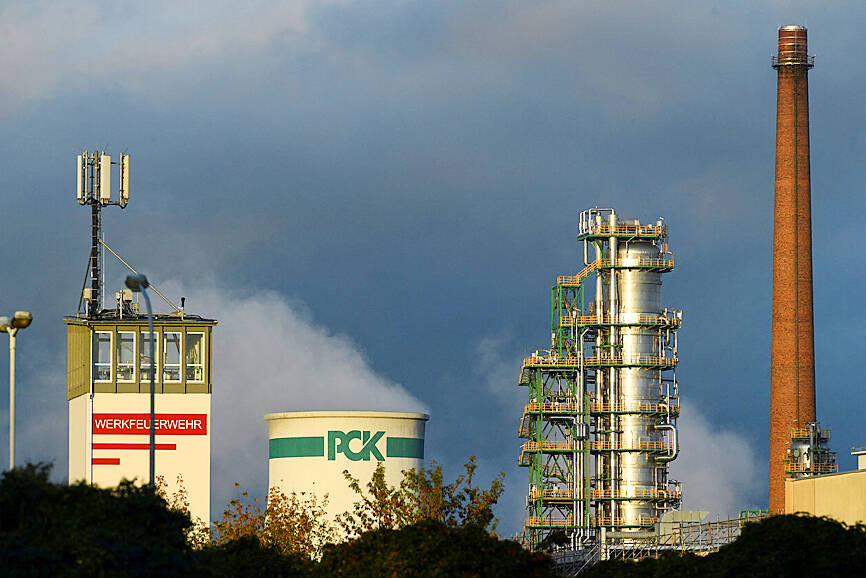Oil recorded its first weekly loss in a month after erasing most of the gains stemming from OPEC+’s surprise output cut.
Brent crude wiped out almost all of the US$7 that it gained after OPEC and its allies blindsided markets with a pledge to cut production.
Brent crude for June delivery rose 0.69 percent to US$81.66 a barrel on Friday, but posted a weekly decline of 5.39 percent.

Photo: Reuters
West Texas Intermediate for May delivery gained 0.65 percent to US$77.87 a barrel, dropping 5.63 percent from a week earlier.
Global supplies are showing signs of growth with Russia’s crude exports bouncing back above 3 million barrels a day last week, while in global fuel markets, gasoline and diesel are slowing at a time when they should be increasing or peaking.
Asian refiners are considering cutting volumes as margins have weakened recently, signaling that refineries did not manage to pass on higher costs to consumers.
“It appears that some of the excitement around the OPEC+ cuts has faded, amid light flows,” Standard Chartered PLC executive director of energy research Emily Ashford said.
Technical indicators also took a toll on prices. The US benchmark failed to break through its 200-day moving average last week and has been trading lower ever since.
The US$7 jump in prices after the OPEC+ announcement created a so-called chart gap, which then prompted a corrective move to the downside to fill the large break in prices.
Last month oil hit a 15-month low in the aftermath of bank turmoil that shook confidence across all markets. The combination of the surprise announcement by OPEC+ on production cuts coupled with a reduction in Iraqi flows pushed oil back into the US$80 range.
Many market watchers are still betting on a rebound in demand from China, which grew its economy at the fastest pace in a year, putting the country on track to reach its growth goal.
Additional reporting by staff writer

SEEKING CLARITY: Washington should not adopt measures that create uncertainties for ‘existing semiconductor investments,’ TSMC said referring to its US$165 billion in the US Taiwan Semiconductor Manufacturing Co (TSMC, 台積電) told the US that any future tariffs on Taiwanese semiconductors could reduce demand for chips and derail its pledge to increase its investment in Arizona. “New import restrictions could jeopardize current US leadership in the competitive technology industry and create uncertainties for many committed semiconductor capital projects in the US, including TSMC Arizona’s significant investment plan in Phoenix,” the chipmaker wrote in a letter to the US Department of Commerce. TSMC issued the warning in response to a solicitation for comments by the department on a possible tariff on semiconductor imports by US President Donald Trump’s

The government has launched a three-pronged strategy to attract local and international talent, aiming to position Taiwan as a new global hub following Nvidia Corp’s announcement that it has chosen Taipei as the site of its Taiwan headquarters. Nvidia cofounder and CEO Jensen Huang (黃仁勳) on Monday last week announced during his keynote speech at the Computex trade show in Taipei that the Nvidia Constellation, the company’s planned Taiwan headquarters, would be located in the Beitou-Shilin Technology Park (北投士林科技園區) in Taipei. Huang’s decision to establish a base in Taiwan is “primarily due to Taiwan’s talent pool and its strength in the semiconductor

Industrial production expanded 22.31 percent annually last month to 107.51, as increases in demand for high-performance computing (HPC) and artificial intelligence (AI) applications drove demand for locally-made chips and components. The manufacturing production index climbed 23.68 percent year-on-year to 108.37, marking the 14th consecutive month of increase, the Ministry of Economic Affairs said. In the first four months of this year, industrial and manufacturing production indices expanded 14.31 percent and 15.22 percent year-on-year, ministry data showed. The growth momentum is to extend into this month, with the manufacturing production index expected to rise between 11 percent and 15.1 percent annually, Department of Statistics

An earnings report from semiconductor giant and artificial intelligence (AI) bellwether Nvidia Corp takes center stage for Wall Street this week, as stocks hit a speed bump of worries over US federal deficits driving up Treasury yields. US equities pulled back last week after a torrid rally, as investors turned their attention to tax and spending legislation poised to swell the US government’s US$36 trillion in debt. Long-dated US Treasury yields rose amid the fiscal worries, with the 30-year yield topping 5 percent and hitting its highest level since late 2023. Stocks were dealt another blow on Friday when US President Donald